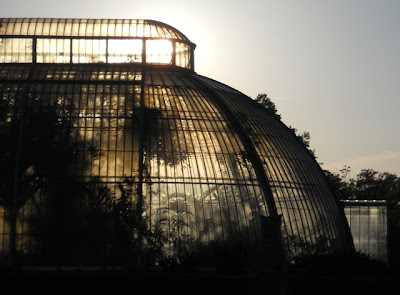The Palm House, puritanical proclivities counterpoised by instinctive ebullience
This is my favourite view of the Palm House. Late in the afternoon (or evening if it's summer), with the setting sun behind it and a palm frond or two in silhouette.
It's also similar to the image used on the latest edition (2007) of Ray Desmond's The History of the Royal Botanic Gardens Kew, which I'll dip into for this post.
I was thinking about the Palm House this week while doing an interview about the Pagoda, another of the 'iconic' buildings at Kew Gardens. The Pagoda was designed by William Chambers and built in 1762. Along with the Orangery, the ruined arches and a few of the Temples, it is all that remains that time. Chambers was tutor to George III (when he was merely a Prince) and worked for his mother, Princess Augusta, when she created the nucleus of Kew Gardens in 1759.
The Palm House came nearly a century later. While the Pagoda was clearly out of place and reactions to it at the time were mixed (from 'whimsical' to 'exotic' to the 'puerile effort of an overgrown boy’), the Palm House seemed to be an immediate success, at least after it was finished...
According to Desmond, the 'first rib' was in place in 1845, and the final coat of paint applied in 1849. The design emerged from a series of competing ideas by Richard Turner and Decimus Burton. The final curved structure supported by wrought iron was from the head of Turner, but both continued to nibble away at the plans before construction began.
There were debates about what kind of glass would work best - sheet or crown - and what colour would best serve the plants - eventually settling on pea-green. The location was debated, with concern about whether boilers would be flooded in its final position next to the pond.
Like Sydney's Opera House, the result was worth the controversy and cost. As Desmond puts it (and I wouldn't dare use these words but love them!) "The puritanical proclivities of Burton were counterpoised by Turner's instinctive ebullience". Desmond then goes to describe the Palm House as Kew's "most beautiful building; seen at sunset on a summer's evening from the far side of the Pond, it becomes an insubstantial bubble enveloping the silhouettes of tall trees, a memorable symbol of Victorian competence and confidence". I like that, particularly confidence.
Others raved about it at the time - 'an English masterpiece' and 'a building of great beauty and wonder' (Alex Clifton-Taylor, quoted by Ray Desmond).
Still, there is always someone still not happy. The Curator of Kew Gardens, John Smith, said it "reminded him of a giant railway station or some dockyard smithy". His concerns were mostly about its suitability for growing plants, as they should have been. In time a few internal adjustments were made and Smith was able to grow some impressive palms and climbers, keeping him relatively happy it seems.
Over the next hundred years there were changes to the glass, the heating and the watering system. In 1959 the Palm House was fully renovated, and again in 1990.
It's due for another in the next decade or two, when you may be lucky enough to see the Palm House without palms, or indeed any plants. You can then test for yourself my comments in an earlier post, summed up by Arthur Hellyer who in 1990 (according to Desmond) said "...the Palm House is more lovely than I have ever known it. It is the first time I have ever seen it without plants and, though as a gardener I hate to admit this, it is even more beautiful without them".
I'll leave you with the Palm House, with plants, on a summer's day.



Comments